Do you have a question about the Hitachi 130-3 and is the answer not in the manual?
Explains the meaning of safety alert symbols and their importance for personal injury prevention.
Defines signal words (DANGER, WARNING, CAUTION, IMPORTANT, NOTE) and their hazard levels.
Emphasizes reading and adhering to all safety signs, messages, and maintaining proper machine condition.
Advises keeping first aid kits and fire extinguishers readily available and establishing emergency guidelines.
Details using handholds and steps correctly and ensuring safety before leaving the operator's seat.
Stresses the importance of fastening the seat belt at all times during operation to minimize injury risk.
Provides guidelines for safe movement, operating from the seat, and handling starting aids.
Emphasizes investigating job sites, ground conditions, and potential hazards before starting work.
Warns against tipping and provides methods to avoid it, especially on slopes or uneven terrain.
Advises on maintaining safe distances from power lines and precautions during lightning storms.
Covers safe practices for lifting loads, using chains, and preventing accidents.
Details safe parking procedures and precautions for handling flammable fluids to prevent fires.
Outlines procedures for safe maintenance, including work area preparation and securing the machine.
Covers checks for oil leaks, electrical shorts, flammable cleanups, and key switch function.
Provides procedures for evacuating in case of fire and warnings about exhaust fumes.
Identifies and labels the various controls and features within the operator's cab.
Explains how to use the monitor screens and displays, including starting and basic screens.
Details the layout of the multi-function monitor, including displays for work mode, fuel, and alarms.
Shows how alarm marks are displayed on the basic screen when abnormalities occur.
Lists various alarms, their contents, and the recommended remedies for each.
Explains how to select and confirm attachments using the work mode screen.
Guides the user on selecting attachments from the main menu and work mode screen.
Explains how the auto-idle function saves fuel by reducing engine speed when controls are neutral.
Explains the function and operation of the pilot control shut-off lever for safety and machine immobilization.
Describes methods for escaping the cab in emergency situations via doors or windows.
Emphasizes the importance of checking seat belt condition and timely replacement for safety.
Lists daily checks for electrical system, boom, bucket, hardware, fuel, and hydraulic systems.
Details confirmations required before starting the engine, including pilot control lever and seat belt.
Explains how to check monitor functions after starting the engine to ensure proper operation.
Describes the correct steps for stopping the engine, including cooling the turbocharger and parking.
Provides essential precautions for driving the machine, especially in freezing weather or on rough terrain.
Provides instructions and cautions for towing the machine a short distance using wire ropes and shackles.
Outlines procedures for parking the machine on level surfaces or slopes to prevent accidents.
Explains the function and operation of the ISO pattern control levers for machine movements.
Explains the function and operation of the pilot control shut-off lever for safety and machine immobilization.
Explains how to select work modes for optimal hydraulic circuit and pump flow rate for attachments.
Warns against using travel force for digging or lifting with the machine's weight to prevent damage.
Warns about reduced stability and potential damage when using breakers, advising slow movements.
Provides essential guidelines for performing maintenance and inspections correctly and safely.
Stresses the importance of using only recommended fuels, lubricants, and genuine Hitachi parts.
Outlines essential steps to prepare the machine safely before commencing any maintenance procedures.
Guides the user on checking the engine oil level daily and the procedure for changing engine oil.
Provides instructions for inspecting and maintaining hydraulic equipment, including safety precautions.
Covers safety precautions related to radio communication equipment, electrical installations, and battery handling.
Explains how to check and replace fuses to resolve electrical equipment failures, including fusible links.
Details how to check bucket teeth for wear and the procedure for replacing worn teeth.
Emphasizes the importance of maintaining seat belt functionality and replacing it every three years.
Details the procedure for checking and adjusting track sag to ensure proper tension and prevent damage.
Lists common issues preventing engine start and their potential causes and solutions.
Addresses problems like engine not developing full power or overheating, providing potential causes and solutions.
Covers low oil pressure, excessive oil usage, and fuel consumption problems with their causes and solutions.
Addresses problems related to excessive exhaust smoke and irregular engine running, with troubleshooting steps.
Lists common electrical system issues, such as starting problems and indicator light failures, with solutions.
Covers troubleshooting for stiff, loose, or non-returning control levers and slow or overheating hydraulic functions.
Guides on checking track sag and adjusting it by loosening or tightening the track.
Offers key points to keep in mind for safe and effective blade operation, avoiding damage.
Warns against unsafe practices when using the offset function, such as jacking the machine or using heavy attachments.
Details the procedure for replacing bucket teeth using the transverse-type pin system, including safety.
Covers the safe handling of suspended loads using the machine's lifting hook and related safety devices.
Provides lifting capacity charts for various configurations, indicating load limits and reach.
Explains the meaning of safety alert symbols and their importance for personal injury prevention.
Defines signal words (DANGER, WARNING, CAUTION, IMPORTANT, NOTE) and their hazard levels.
Emphasizes reading and adhering to all safety signs, messages, and maintaining proper machine condition.
Advises keeping first aid kits and fire extinguishers readily available and establishing emergency guidelines.
Details using handholds and steps correctly and ensuring safety before leaving the operator's seat.
Stresses the importance of fastening the seat belt at all times during operation to minimize injury risk.
Provides guidelines for safe movement, operating from the seat, and handling starting aids.
Emphasizes investigating job sites, ground conditions, and potential hazards before starting work.
Warns against tipping and provides methods to avoid it, especially on slopes or uneven terrain.
Advises on maintaining safe distances from power lines and precautions during lightning storms.
Covers safe practices for lifting loads, using chains, and preventing accidents.
Details safe parking procedures and precautions for handling flammable fluids to prevent fires.
Outlines procedures for safe maintenance, including work area preparation and securing the machine.
Covers checks for oil leaks, electrical shorts, flammable cleanups, and key switch function.
Provides procedures for evacuating in case of fire and warnings about exhaust fumes.
Identifies and labels the various controls and features within the operator's cab.
Explains how to use the monitor screens and displays, including starting and basic screens.
Details the layout of the multi-function monitor, including displays for work mode, fuel, and alarms.
Shows how alarm marks are displayed on the basic screen when abnormalities occur.
Lists various alarms, their contents, and the recommended remedies for each.
Explains how to select and confirm attachments using the work mode screen.
Guides the user on selecting attachments from the main menu and work mode screen.
Explains how the auto-idle function saves fuel by reducing engine speed when controls are neutral.
Explains the function and operation of the pilot control shut-off lever for safety and machine immobilization.
Describes methods for escaping the cab in emergency situations via doors or windows.
Emphasizes the importance of checking seat belt condition and timely replacement for safety.
Lists daily checks for electrical system, boom, bucket, hardware, fuel, and hydraulic systems.
Details confirmations required before starting the engine, including pilot control lever and seat belt.
Explains how to check monitor functions after starting the engine to ensure proper operation.
Describes the correct steps for stopping the engine, including cooling the turbocharger and parking.
Provides essential precautions for driving the machine, especially in freezing weather or on rough terrain.
Provides instructions and cautions for towing the machine a short distance using wire ropes and shackles.
Outlines procedures for parking the machine on level surfaces or slopes to prevent accidents.
Explains the function and operation of the ISO pattern control levers for machine movements.
Explains the function and operation of the pilot control shut-off lever for safety and machine immobilization.
Explains how to select work modes for optimal hydraulic circuit and pump flow rate for attachments.
Warns against using travel force for digging or lifting with the machine's weight to prevent damage.
Warns about reduced stability and potential damage when using breakers, advising slow movements.
Provides essential guidelines for performing maintenance and inspections correctly and safely.
Stresses the importance of using only recommended fuels, lubricants, and genuine Hitachi parts.
Outlines essential steps to prepare the machine safely before commencing any maintenance procedures.
Guides the user on checking the engine oil level daily and the procedure for changing engine oil.
Provides instructions for inspecting and maintaining hydraulic equipment, including safety precautions.
Covers safety precautions related to radio communication equipment, electrical installations, and battery handling.
Explains how to check and replace fuses to resolve electrical equipment failures, including fusible links.
Details how to check bucket teeth for wear and the procedure for replacing worn teeth.
Emphasizes the importance of maintaining seat belt functionality and replacing it every three years.
Details the procedure for checking and adjusting track sag to ensure proper tension and prevent damage.
Lists common issues preventing engine start and their potential causes and solutions.
Addresses problems like engine not developing full power or overheating, providing potential causes and solutions.
Covers low oil pressure, excessive oil usage, and fuel consumption problems with their causes and solutions.
Addresses problems related to excessive exhaust smoke and irregular engine running, with troubleshooting steps.
Lists common electrical system issues, such as starting problems and indicator light failures, with solutions.
Covers troubleshooting for stiff, loose, or non-returning control levers and slow or overheating hydraulic functions.
Guides on checking track sag and adjusting it by loosening or tightening the track.
Offers key points to keep in mind for safe and effective blade operation, avoiding damage.
Warns against unsafe practices when using the offset function, such as jacking the machine or using heavy attachments.
Details the procedure for replacing bucket teeth using the transverse-type pin system, including safety.
Covers the safe handling of suspended loads using the machine's lifting hook and related safety devices.
Provides lifting capacity charts for various configurations, indicating load limits and reach.
| Brand | Hitachi |
|---|---|
| Model | 130-3 |
| Category | Excavators |
| Language | English |

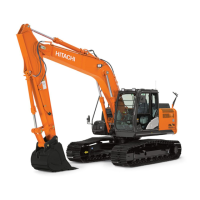

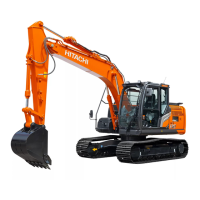




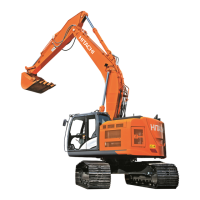
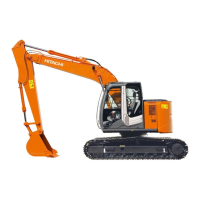

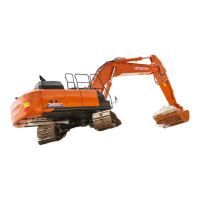
